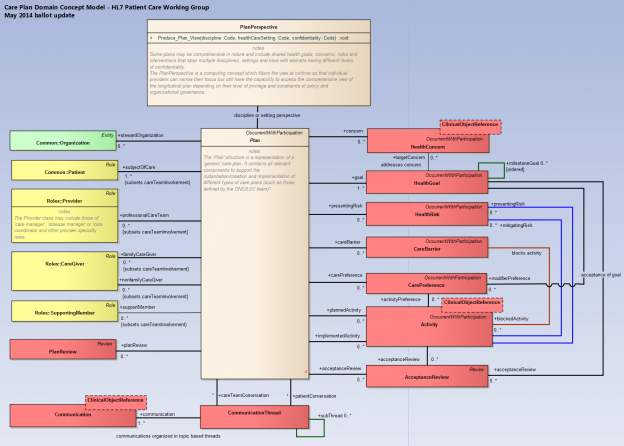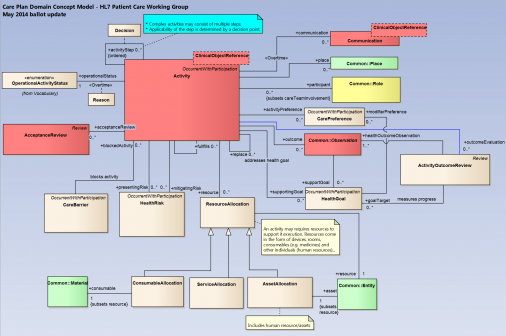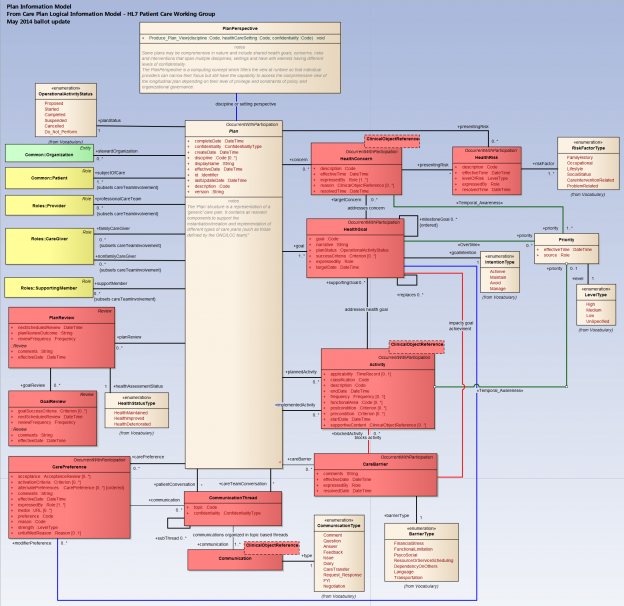Care Plan
Contents
- 1 Care Plan Model Overview
- 2 The Plan Conceptual Model
- 3 Plan Activities Conceptual Model
- 4 Health Goals Conceptual Model
- 5 Plan Reviews Conceptual Model
- 6 Plan Logical Information Model
- 7 Plan Activities Logical Information Model
- 8 Health Goals Logical Information Model
- 9 Plan Reviews Logical Information Model
- 10 Working Model and Documents
- 11 References
Care Plan Model Overview
48x48px Many updates are needed for the wiki to reflect the latest model and content from the Care Plan DAM 2013 ballot document.
The Care Plan structure is used to define the management action plans for the various concerns identified for the target of care. It is the structure in which the care planning for all individual professions or for groups of professionals can be organized, planned and checked for completion. Communicating explicitly documented and planned actions and goals greatly aids the team in understanding and coordinating the actions that need to be performed for the person. Care plans also permit the monitoring and flagging of unperformed activities and unmet goals for later follow up.
“The Care Plan represents the synthesis and reconciliation of the multiple plans of care produced by each provider to address specific health concerns. It serves as a blueprint shared by all participants to guide the individual’s care. As such, it provides the structure required to coordinate care across multiple sites, providers and episodes of care.” Care Plan Terms & Proposed Definitions (DRAFT v24), S&I Longitudinal Coordination of Care WG (S&I LCC Glossary).
The HL7 patient care “Plan” model supports the documentation and execution of a plan tailored for different health care scenarios. The plan represents an emergent process, unfolding process, which is continuously changing based on feedback from various participants which include: the patient, the patient’s family, the care team and other support individuals such as those dealing with financial aspects. The model is structured in such a way to support the following views based on the S&I Longitudinal Care Coordination glossary definitions.
- The “Plan of Care” view supports individual providers in addressing either single or multiple conditions
- The “Care Plan” supports a composite and reconciled view of multiple “Plans of Care” addressing multiple provider care specialty perspectives (e.g. cardiology, nutrition, physical therapy, pharmacist, etc.)
In the HL7 patient care model the “Care Plan” and “Plan of Care” share the same essential characteristics of goals, concerns, plan actions, care team, etc. As such, the “Care Plan” is modeled to inherit the characteristics of the “Plan of Care” but in addition the “Care Plan” also supports composition of multiple specialized “Plans of Care”. The structuring is flexible in order to accommodate different organization process and policy decisions.
The “Plan” model consists following key structural and content characteristics:
- Health concerns which represent the focus or reason for establishing the plan.
- Health goals mutually agreed on by the patient and one or more care team members
- Proposed actions to address the goals and any required acceptance reviews necessary for implementation
- Implemented actions and outcomes which are reviewed against the health goals
- Known health risks requiring management via mitigating actions
- Care barriers blocking progress towards the wellbeing of the patient and success towards goals
The planning process which leads to the establishment of the “Care Plan” is a dynamic and emergent process with the following aspects:
- It involves dynamic and unpredictable interactions between care planning and execution participants
- patient, family, care team or administrative support staff
- It requires constant communication between participants who may change the state of individual actions at any time
- The progression of actions may follow any sequencing or may happen in parallel in an unpredictable manner
- Goals may change at any time based on feedback from any of the participants
- Actions may be suspended, changed or abandoned at any time based on new knowledge from any of the participants due to patient preferences, barriers or the outcome of interventions.
The Plan Conceptual Model
Plan Activities Conceptual Model
Health Goals Conceptual Model
Plan Reviews Conceptual Model


